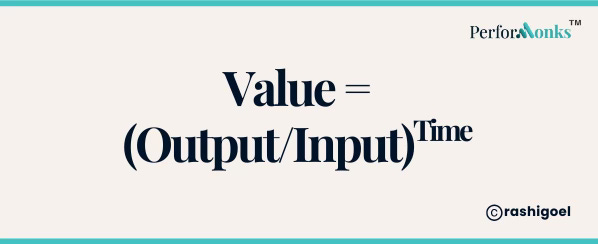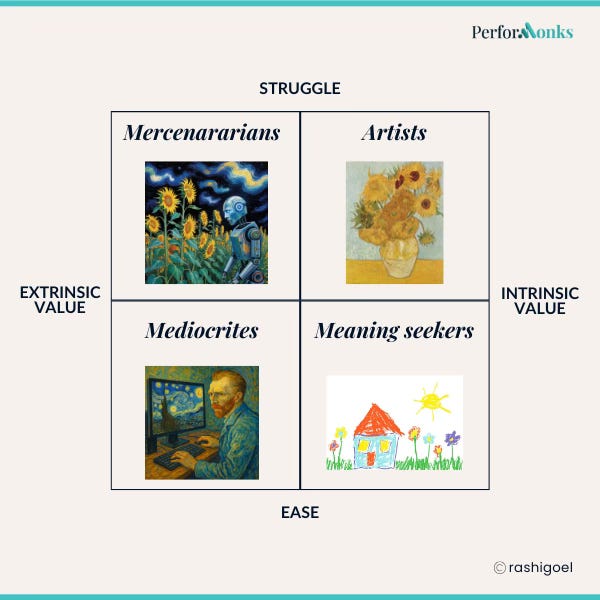One singular force has driven humankind for centuries and will continue to drive us → we seek value in everything.
Each one of us has a deeply personal definition of value, but if we were to generalise, it might look like this –
We decide for how long (time) we want to put in effort (input) to get what we want (output)

There are four nuances here.
1. We constantly weigh our input against the output
I know I will walk the 31km from Gurgaon to Lajpat Nagar to raise funds for a charity I like. Google Maps tells me it will take me 6 hours and 16 minutes.
I am willing to put in this effort, but only once a year, because my personal algorithm tells me this discomfort is worth the cause my charity supports.
Ergo, the more valuable the output, the more effort we are willing to invest.
2. The meaning we assign to output or input completely changes our approach
If I am made to repeat this daily, my life turns into a Sisyphean struggle.
A struggle I would not undertake for anything.
Unless that ‘anything’ is to save my hypothetical child from cancer. In such a scenario, I have given this act an intrinsic meaning or I am intrinsically motivated.
(Other intrinsic motivators are mastery, personal growth, joy of creation, caring for loved ones.)
I might even do this is if I want to feature in the Guinness book of records – here, I am extrinsically motivated.
(Name, fame, money, designation, are other extrinsic motivators.)
Extrinsically motivated people start with an output focus and tailor their input (effort, struggle) to the output they desire.
Intrinsically motivated people start with an input focus. If output follows, it is good. If it does not, that’s ok too.
3. It takes time to build something durable
It’s like rabbits vs. elephants.
Rabbits breed 3-4 times a year and each time, have 4-5 babies. Each baby’s lifespan is just 3 years, that too only if they don’t perish in an accident or become a predator’s lunch first.
An elephant’s gestation period is 22 months. They breed only once every 4-5 years and live to 70.
Don’t get me wrong, both elephants and rabbits are critical and valuable to mother nature, it’s just that elephants are more durable.
The longer we work at something, the more durable our output.
4. It takes time and struggle to cultivate mastery
An elephant is input focussed. She patiently waits for her baby to grow for 22 months. (Not easy to carry a baby for two years. Ask mom.)
The only way I will continue to work at something even without seeing any outcome, is if I am input focussed, if I am intrinsically motivated.
On the other hand, if I am extrinsically thirsty, I might be able to hack mastery if I build a system that periodically gets me quick pats on the back, which keep me going strong for long. (Durex, I have copyright on this).
Extrinsically driven people can hack their brains to stay invested for a long time by building a system of periodic wins.
But they will still need to keep putting in effort over time.
Which brings us to the question.
How will AI upend this complex relationship between input, output and time?
It takes centuries to change what has existed for centuries, so, AI will not change the fundamental rules of this equation. But it could –
- Shrink the surface area of intrinsic value seekers, and therefore, make them more valuable
- Fool extrinsic value seekers into thinking they are working hard and building mastery
- Change the definition of what it means to struggle with AI as a partner
A post-AI world will have 4 types of people.

I will share my take on each of these in the next edition!
More ways to connect
- Connect on: Linkedin
- Read Archives
- Subscribe to Newsletter
